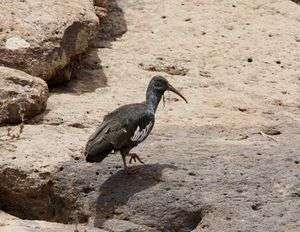Wattled ibis
| Wattled ibis | |
|---|---|
 | |
| In Ethiopia | |
| Scientific classification | |
| Kingdom: | Animalia |
| Phylum: | Chordata |
| Class: | Aves |
| Order: | Pelecaniformes |
| Family: | Threskiornithidae |
| Subfamily: | Threskiornithinae |
| Genus: | Bostrychia |
| Species: | B. carunculata |
| Binomial name | |
| Bostrychia carunculata (Rüppell, 1837) | |
The wattled ibis (Bostrychia carunculata) is a species of bird in the family Threskiornithidae. It is endemic to the Ethiopian highlands and is found only in Ethiopia and Eritrea.
Description
A large, dark ibis with white shoulder patches and white eyes. A thin wattle hangs from the base of the broad bill. These two features, and no white line on cheek, distinguish this ibis from its close relative the hadada ibis (Bostrychia hagedash). The average length is 60 cm.
Range and habitat
They may occur all over Ethiopian highlands at altitudes ranging from 1500 m to the highest moorlands at 4100 m. It has also been recorded on the coast of Eritrea. It prefers meadows and highland river courses. It is often found in rocky places and cliffs (where it roosts and breeds), but also in open country, cultivated land, city parks and olive tree (Olea africana) and juniper (Juniperus procera) mixed forests. It has also become well adapted to anthropic landscapes and conditions; during the rainy season it can be seen in the hotel lawns of downtown Addis Ababa. The wattled ibis is common to abundant.
General habits
The wattled ibis is a gregarious species, often flocking in groups of 30 to 100, but it also can be seen feeding alone or in pairs. It forages in open grasslands, marshes, open alpine moorlands, croplands and forest glades. When feeding it walks about methodologically, probing the ground regularly. It feeds on worms, insect larvae, and small invertebrates; occasionally frogs, snakes and mice. Sometimes it is seen with herds of domestic animals, searching dung for beetles. It roosts singly or in pairs in trees, in groups on rock cliffs, often at sites of breeding colonies. The wattled ibis is predominantly sedentary, undertaking only local, altitudinal movements.
Breeding habits
The wattled ibis usually nests in small to large colonies on rocky cliffs, over bushes hanging in the walls, but it has also been reported to nest singly on top of trees or ledges of buildings. Few colonies are known above 3000 meters, and those in trees at lower elevations (1800 – 2000 m) in Lake Awasa. In the Bale Mountains there are nesting colonies of 500 or more birds. The nest is a platform of branches and sticks, lined with grass and strips of bark; sometimes at high and cold altitudes, they are located to the east for maximum exposure to morning sun. The wattled ibis breeds from March to July; and occasionally in December, during the dry season. It lays two or three rough shelled eggs which are dirty white in color.
Threats
No reduction in numbers nor any obvious threat have been reported. Therefore, it is not considered to be of conservation concern, since the population is rather large.
References
- ↑ BirdLife International (2012). "Bostrychia carunculata". IUCN Red List of Threatened Species. Version 2013.2. International Union for Conservation of Nature. Retrieved 26 November 2013.
- Jose Luis Vivero Pol, 2006, A Guide to Endemic Birds of Ethiopia and Eritrea. Shama Books. ISBN 1-931253-13-7
